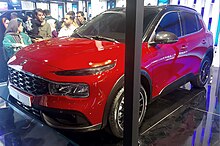
Iran’s automotive industry is the third most active industry of the country, after its oil and gas industry, accounting for 10% of Iran's GDP and 4% of the workforce (700,000 people).[1][2][3]
Iran developed a significant automotive industry with annual production of up to 200,000 units under the Mohammad Reza Shah Pahlavi's regime. But after the Iranian Revolution of 1979 production drastically decreased due to Iran–Iraq War and international sanctions. Since the early 2000s, automobile production in Iran has grown exponentially. Iran's automobile production crossed the 1 million mark in 2007/2008. Today, Iran is the 20th largest automaker in the world and one of the largest in Asia, with annual production of more than 1.6 million.[citation needed] In 2009, Iran ranked fifth in car production growth standing next to China, Taiwan, Romania and India.[4][5] According to OICA statistics, production dropped dramatically to under 750,000 automobiles and commercial vehicles in 2013.[6]
As of 2001, there were 13 public and privately owned automakers in Iran, of which two—Iran Khodro and Saipa—accounted for 94% of the total domestic production. Iran Khodro, which produced the most prevalent car brand in the country—the Paykan, which has been replaced in 2005 by the Samand—was still the larger with 61% of the market in 2001, while Saipa contributed 33% of Iran's total production in the same year.[7] Iran Khodro is one of the largest car manufacturers in Asia. It has established joint-ventures with foreign partners on 4 continents.
The Iranian manufacturers currently produces Several types of vehicles, including cars, 4WD, trucks, buses, minibuses, and pickup trucks. The sector directly employs about 500,000 people (roughly 2.3% of the workforce), and many more in related industries. About 75% of local output is passenger cars, with pick-ups the next largest category, accounting for around 15%.[8]
In 2024 July Iran started allowing importing second hand Japanese, Korean and European cars limited to 1 exclusive vehicle purchase per citizen National id card number.[9]
- ^ Cite error: The named reference
Atiehwas invoked but never defined (see the help page). - ^ Iran’s automakers stalled by sanctions Archived 2017-09-05 at the Wayback Machine. Washington Post, October 14, 2013.
- ^ "بررسي سيستم هاي الكترونيكي خودرو - 1 - مرکز پژوهش های صنعت الکترونیک کشور". eirc.ir. Archived from the original on 2015-11-17. Retrieved 2015-11-20.
- ^ "Iran Ranks 5th in Car Production Growth". Fars News. 2010-08-18. Archived from the original on 2012-03-01. Retrieved 2010-11-28.
- ^ PWKD. "Petrol World - Iran: Mobile App For Online Fuel Purchase Launch". www.petrolworld.com. Archived from the original on 2019-02-28. Retrieved 2019-02-28.
- ^ "2013 Statistics - OICA". Archived from the original on 11 June 2015. Retrieved 10 June 2015.
- ^ "SAPCO: Iran Automotive Industry's Market Shares (September 2001)". Archived from the original on 2008-06-17. Retrieved 2011-05-29.. Retrieved November 14, 2008.
- ^ Economist Intelligence Unit (August 18, 2008). "Iran Automotive Forecast". Economist.
- ^ "اعلام شرایط واردات خودروهای کارکرده + عکس و جزئیات" [Announcement of conditions for import of used cars + photos and details]. Etemad (in Persian). 19 July 2024. Archived from the original on 14 November 2024. Retrieved 19 July 2024.